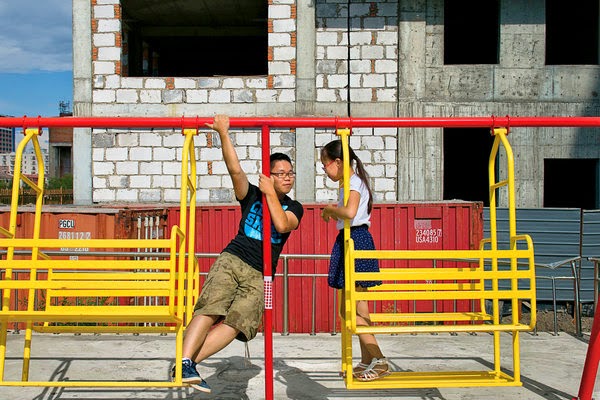Days before I was to meet Battushig Myanganbayar at his home in Mongolia, he sent me an e-mail with a modest request: Would I bring him a pair of tiny XBee wireless antennas? Electronic parts are scarce in Mongolia (he used components from old elevators for some of his projects), and packages ordered online take weeks to show up.
“My vision,” he told me, “is to have more skilled engineers to develop Mongolia. To do that, everything has to start from the beginning.” In the past decade, Mongolia, which had limited landlines, invested heavily in its information technology infrastructure and now has an extensive 3G network. Most homes in Ulan Bator have Internet connections, and almost everyone, including nomads, has at least one cellphone. Even on the steppe, with only sheep in sight, you can get a signal. Zurgaanjin had students watch the Circuits and Electronics MOOC lectures at home, just like thousands around the world, but he wanted to supplement them with real-world labs. Tony Kim, a college friend working on his Ph.D. in electrical engineering at Stanford, agreed to visit Mongolia for 10 weeks and guide students through the labs using real equipment. Kim brought three suitcases of electronics supplies, immediately making his classroom one of the best-equipped labs in the entire country. Because the class was not approved by the ministry of education, students had to take it in addition to their regular courses. Battushig persuaded his parents to upgrade the Internet speed at their home from 1 megabit per second to 3 (the average in the United States is 8.6) to make it easier to watch the lectures. Battushig was one of 20 students, ranging in age from 13 to 17, to enroll in the class. About half dropped out. The course is difficult in any setting — M.I.T. sophomores often pull all-nighters — and the Mongolian students were taking it in a second language. Battushig, however, thrived. “I can’t compare it to a regular class,” he said. “I had never done that kind of thing before. It was really a watershed moment for me.” To help his classmates, he made videos in Mongolian that offered pointers and explanations of difficult concepts and posted them on YouTube. Kim, who had taught similar classes at M.I.T., told me, “If Battushig, at the age of 15, were a student at M.I.T., he would be one of the top students — if not the top.”
In the past year and a half, more than 100 schools, including Harvard, Caltech and the University of Texas, have invested millions of dollars in MOOCs. Many in higher education believe that these courses can make a quality education more affordable and accessible to far more students and eventually provide additional revenue streams for the universities that offer them. Critics, though, argue that MOOCs threaten the economic survival of nonelite colleges and are an inadequate replacement for the teaching and support of live professors. Anant Agarwal, a professor of Circuits and Electronics and the president of edX, a MOOC platform started last year by M.I.T. and Harvard, said that seeing Kim and Zurgaanjin combine his online lectures with in-person teaching spurred edX to help organize 20 such “blended” classes. “It was extraordinarily creative,” he said. “It changed the way I think.”
Battushig’s success also showed that schools could use MOOCs to find exceptional students all over the globe. After the course, Kim and Zurgaanjin suggested that Battushig apply to M.I.T., and he has just started his freshman year — one of 88 international students in a freshman class of 1,116. Stuart Schmill, the dean of admissions, said Battushig’s perfect score proved that he could handle the work. Schmill also said that although M.I.T. already seeks students from around the world, many come via special programs organized by charities or international schools. (Zurgaanjin attended the United World College in Wales before applying to M.I.T.) “The MOOCs may well offer the opportunity for us to get more students from remote areas who haven’t been in these magnet cultures,” Schmill said. Battushig, who is now 17, settled into his German-themed dorm last month, a single in Desmond House. He has begun classes, including introductory courses in electronics, solid-state chemistry and biology, and had his photo taken with the renowned physics professor Walter Lewin (which he posted on Facebook). He joined photography and tennis clubs — and, he said, discovered that “I’m really a great player at billiards.” He is heeding his mother’s warning not to overindulge on pizza (he has a self-imposed limit of two slices a week). Battushig may be embracing student life, but as his father told me months earlier when we sat down to a family lunch of Korean-style kimbap, rice-noodle salad and cooked sheep: “He is thinking, all the time, how to solve problems. He has so many ideas. He often says to me, ‘I want to make good things for humans.’ If he does good things for humans, he does a great thing for us.”



Post a Comment